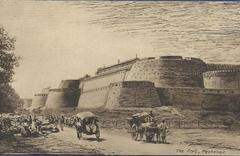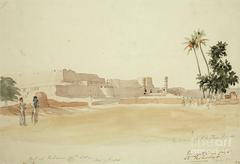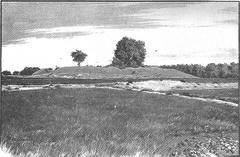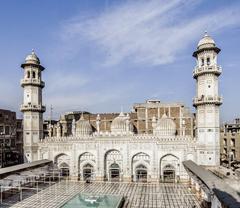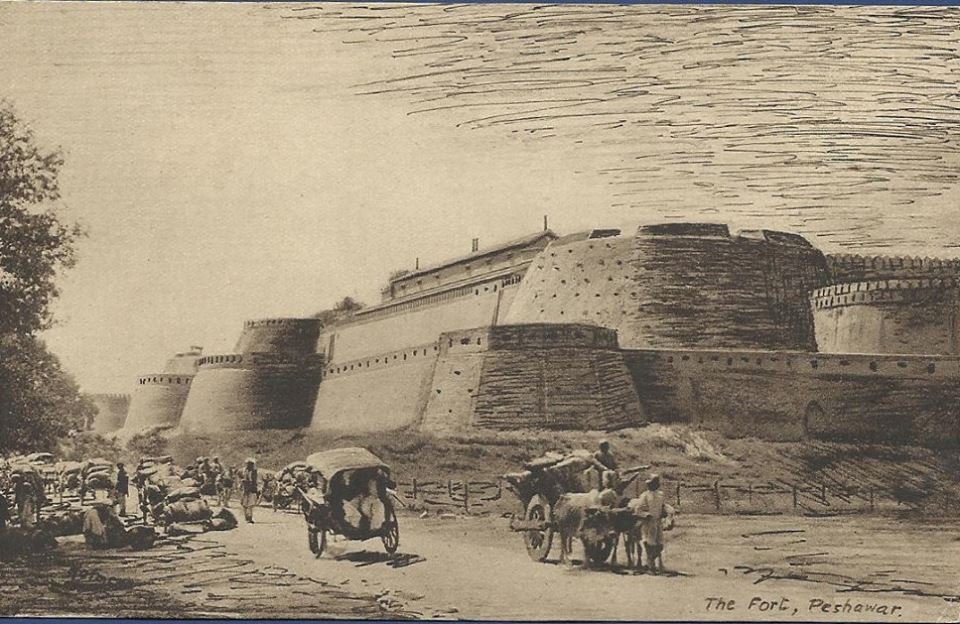
Bala Hisar Fort: Visiting Hours, Tickets, and Historical Significance in Peshawar
Date: 14/06/2025
Introduction
Bala Hisar Fort, perched atop a commanding hill in Peshawar, Pakistan, stands as a monumental symbol of the region’s rich historical legacy and enduring strategic importance. Revered as one of the most significant historical sites in Peshawar, its origins trace back to antiquity—predating even the Mughal era—with references found in the travelogues of the Chinese Buddhist monk Xuanzang around 630 CE. Over centuries, the fort has served as a military bastion, royal residence, and administrative center for numerous empires, reflecting the vibrant and turbulent history of South and Central Asia (Youlin Magazine; Chitral Times). Today, it remains an active military headquarters while welcoming visitors eager to explore its layered past, unique architecture, and panoramic views.
Table of Contents
- Early Origins and Strategic Location
- Dynastic Control and Architectural Evolution
- Architectural Features and Layout
- Visiting Bala Hisar Fort: Hours, Tickets & Tips
- Cultural and Strategic Significance
- Practical Information: Access, Permits, and Visitor Experience
- Travel Tips and Nearby Attractions
- Frequently Asked Questions (FAQ)
- Conclusion
- Sources and Further Reading
Early Origins and Strategic Location
The origins of Bala Hisar Fort are shrouded in the mists of antiquity. While the current structure is primarily attributed to the Mughal emperors—particularly Akbar in 1586—its significance as a fortified royal residence is evident in much earlier references. Xuanzang, the renowned Chinese Buddhist pilgrim, described a “royal residence on an elevated mound” in Peshawar, which is believed to correspond to the site of present-day Bala Hisar (Youlin Magazine).
Strategically situated on a hilltop, the fort commands views of the Grand Trunk Road—an ancient artery linking South Asia with Central Asia—and controls the approach to the fertile Peshawar valley. This vantage made Bala Hisar an indispensable military and administrative hub for successive empires (Graana).
Dynastic Control and Architectural Evolution
Kushan and Early Empires
Though direct archaeological evidence is limited due to repeated reconstructions, some historians believe the earliest fortifications at Bala Hisar date back to the Kushan Empire, around the 1st century CE. The region’s status as a crossroads for trade and conquest meant that control of the fort was closely tied to control of Peshawar and its lucrative trade routes (Chitral Times; Graana).
Mughal Era
The Mughal period marked a defining moment in the fort’s history. Babur, the founder of the Mughal Empire, refers to the site as “Bagram” in his memoirs, and under Akbar’s reign, the fort was extensively rebuilt, reflecting Mughal military architecture with robust walls and a layout suited for both defense and residence (Visual Pakistan). After its destruction by Sher Shah Suri, Humayun rebuilt Bala Hisar before his campaign into Kabul (Youlin Magazine).
Durrani and Afghan Rule
Following the decline of Mughal authority, the fort became the winter capital of the Durrani Empire, with Ahmad Shah Durrani and his son Timur Shah Durrani using it as a royal residence. The name “Bala Hisar” was given by Timur Shah, meaning “high fort” in Persian (Graana).
Sikh and British Occupation
In the early 19th century, the Sikhs, under Maharaja Ranjit Singh, captured and reconstructed the fort, renaming it “Samir Garh”—a name that did not gain widespread use (Youlin Magazine). The British seized control in 1849, further renovating the fort for military use and reinforcing its defenses, cementing its role as a garrison during the Anglo-Afghan Wars and the Indian Rebellion of 1857 (Visual Pakistan).
Architectural Features and Layout
Bala Hisar Fort spans roughly 10–15 acres, rising about 90 feet above ground level (Graana; Chitral Times). Its red-brick walls, imposing gateways, and bastions reflect a blend of Mughal, Durrani, Sikh, and British architectural influences.
- Defensive Walls and Gates: The fort features concentric layers of defensive walls, with Mughal-era inner sections and British-era outer fortifications (travelpakistani.com; gypsytours.pk).
- Internal Structures: Inside, the fort once housed royal quarters, administrative offices, barracks, and religious sites (mosque and temple), emphasizing its role as both a palace and military stronghold (en.wikipedia.org).
- Museum: An on-site museum displays weapons, uniforms, regimental artifacts, and exhibits on Pashtun culture (arcodesk.com).
- Ramparts: Walkways atop the fort’s walls offer panoramic views of Peshawar and the surrounding mountains.
Visiting Bala Hisar Fort: Hours, Tickets & Tips
Visiting Hours
Bala Hisar Fort is generally open to visitors from 9:00 AM to 5:00 PM, typically on weekends (Saturdays and Sundays), subject to change based on military activities or public holidays. Confirm current timings before your visit (Trip.com).
Entry and Permit Information
- Pakistani Citizens: Entry is free on weekends, with Saturday often reserved for families.
- Foreign Tourists: Access is by special permit only, arranged in advance through the Frontier Corps or local authorities. Submit valid identification and travel details at least a week prior to your visit (laurewanders.com).
- Security: Expect thorough screening; bring your permit and photo ID. Large bags and professional camera equipment may be restricted.
Guided Tours
All visits are conducted as guided tours led by authorized personnel, offering insights into the fort’s military history, architecture, and artifacts (rehlat.ae).
Accessibility
Due to the historic terrain and elevation, accessibility for visitors with mobility issues is limited. Some ramps exist, but stair climbing is required in many areas.
Cultural and Strategic Significance
Bala Hisar Fort has long served as a symbol of authority and resilience for Peshawar and its rulers (military-history.fandom.com). From its use as a royal residence and military bastion to its role as a base for campaigns and governance, the fort embodies the changing tides of regional power. It is closely associated with Pashtun identity and has hosted countless ceremonies, religious gatherings, and public events. Its location at the gateway to the Khyber Pass made it a linchpin in controlling trade and military movement between South and Central Asia.
Practical Information: Access, Permits, and Visitor Experience
- Location: Northwest Peshawar, near the Grand Trunk Road, easily accessible by taxi or local transport (pk.worldorgs.com).
- Permit Process: Contact the Frontier Corps or local authorities to apply for a permit; allow at least one week for processing.
- Dress Code: Modest attire is required; women should cover arms and legs and bring a headscarf (laurewanders.com).
- Facilities: Basic restroom facilities and a souvenir shop are available; food options inside are limited.
- Best Time to Visit: October to March offers pleasant weather; avoid peak summer due to high temperatures (laurewanders.com).
- Photography: Allowed in designated areas only; always seek permission from guides or security.
Travel Tips and Nearby Attractions
- Photography: The ramparts and main gate offer the best spots for panoramic shots of the city and valley.
- Nearby Sites: Enhance your trip by visiting Mahabat Khan Mosque, Qissa Khwani Bazaar, Sethi House Museum, and the Peshawar Museum (rehlat.ae).
- Accommodation: Book hotels in advance, particularly if you are a foreigner; options for international guests may be limited.
- Transport: Local taxis, rickshaws, and ride-hailing apps are readily available; public transport can be confusing for non-locals.
Frequently Asked Questions (FAQ)
Q: What are Bala Hisar Fort’s visiting hours?
A: Generally from 9:00 AM to 5:00 PM on weekends, but always confirm in advance.
Q: Is there an entrance fee?
A: Entry is free for Pakistani citizens; foreign visitors must obtain a permit (no ticket is required, but permit processing may involve a fee).
Q: Are guided tours available?
A: Yes, all visits are guided by authorized personnel.
Q: Is the fort accessible for people with disabilities?
A: Accessibility is limited; much of the fort requires climbing stairs and traversing uneven terrain.
Q: Can I take photographs inside?
A: Photography is permitted in non-sensitive areas; always ask your guide or security staff for permission.
Q: How do I obtain a permit as a foreign visitor?
A: Apply through the Frontier Corps or local authorities with valid ID at least a week in advance.
Conclusion
Bala Hisar Fort is not only a symbol of Peshawar’s historical and strategic legacy, but also a living monument to cultural resilience and identity. Its unique position, storied past, and ongoing military role make it a must-visit for history enthusiasts and culturally curious travelers. Advance planning regarding permits, visiting hours, and travel logistics will ensure a smooth and enriching experience. Don’t miss the opportunity to explore this iconic landmark and the many other historical gems of Peshawar.
For more travel tips and updates, download the Audiala app, follow our social media channels, and consult official tourism resources before planning your visit.
Sources and Further Reading
- Youlin Magazine
- Gypsy Tours
- Military History Fandom
- Trip.com
- Graana
- Visual Pakistan
- Chitral Times
- Khyber Pakhtunkhwa Tourism Department
- travelpakistani.com
- arcodesk.com
- en.wikipedia.org
- laurewanders.com
- rehlat.ae
- pk.worldorgs.com
- historyofpashtuns.blogspot.com
